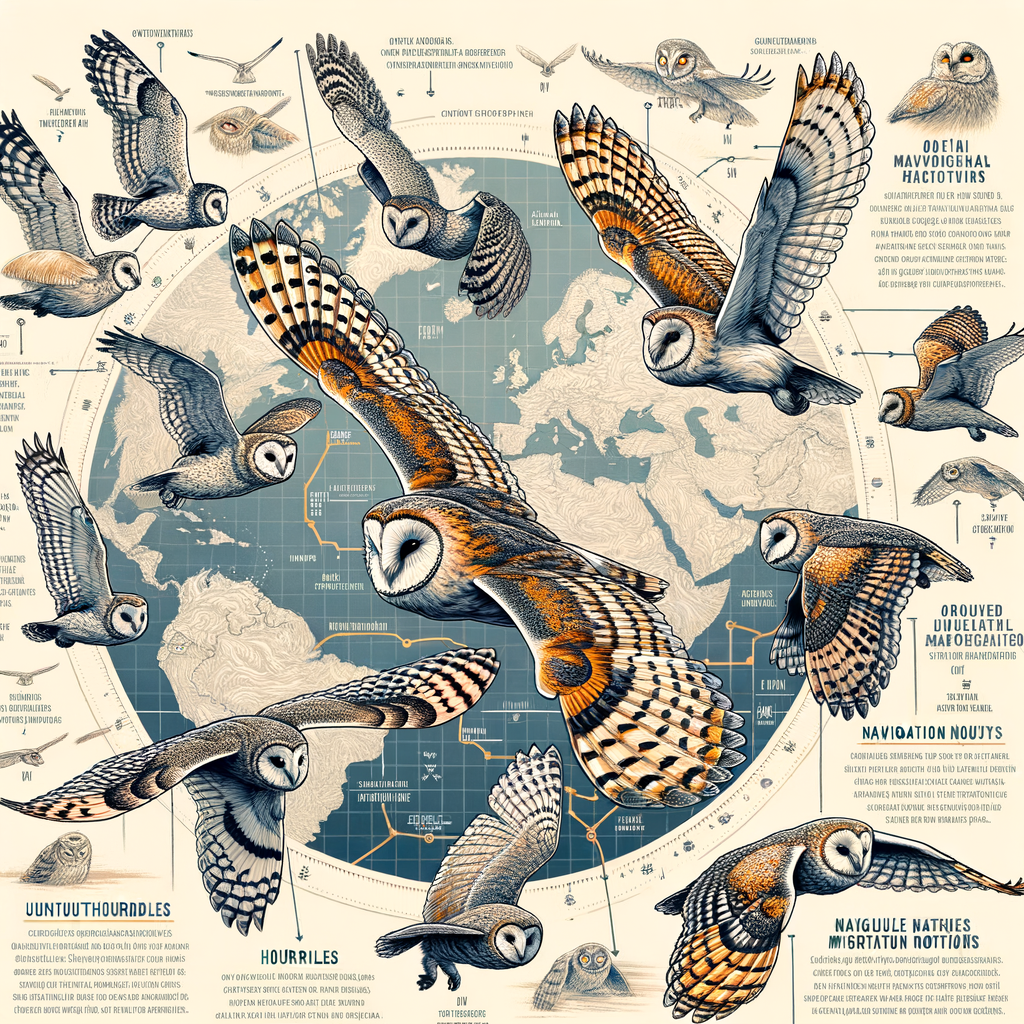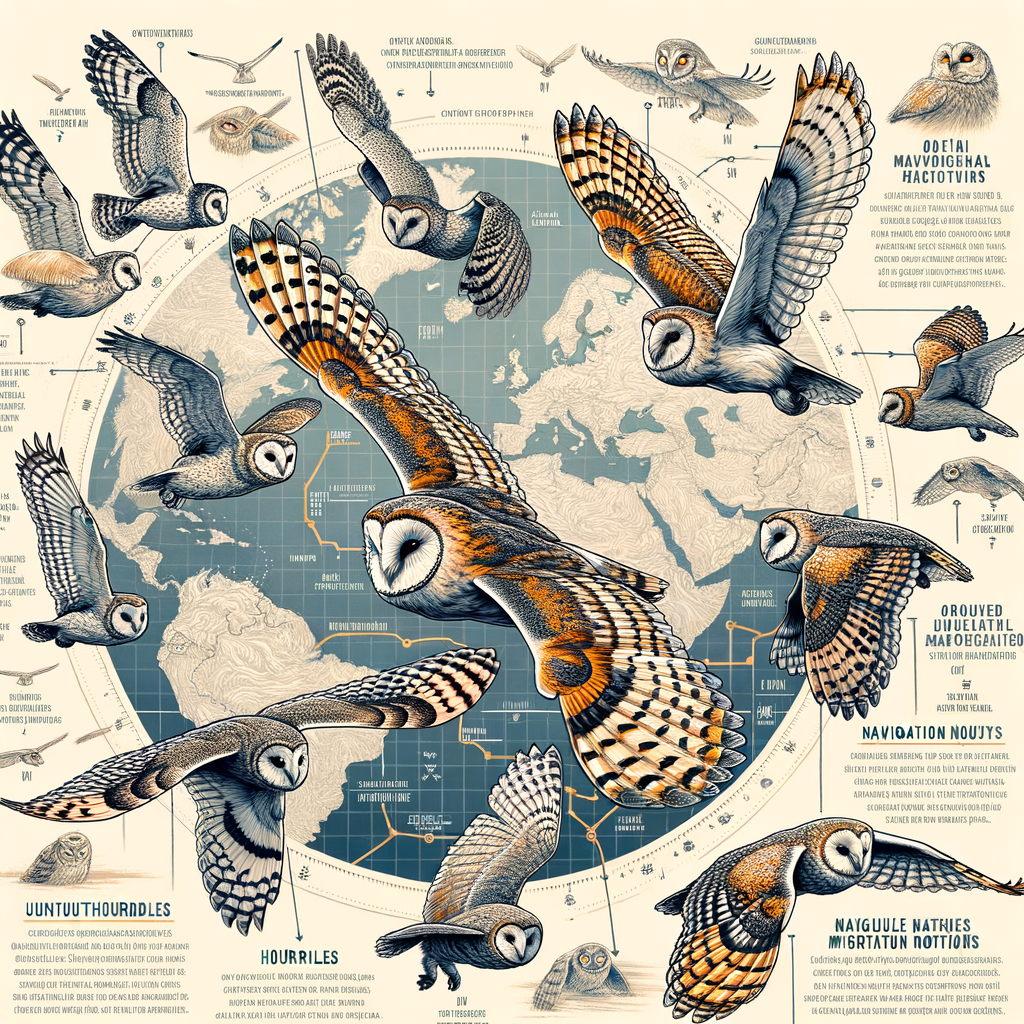
Introduction to The Mysterious Migration Patterns of Owls
Owls are fascinating creatures known for their silent flight and nocturnal habits. But did you know that some owls migrate? Understanding their migration patterns can help us learn more about these mysterious birds.
- Overview of owl migration: Not all owls migrate, but some species do. For example, the Snowy Owl travels long distances between its breeding grounds in the Arctic and its wintering areas in the south. These migrations can be unpredictable and vary from year to year.
- Importance of studying owl migration: Studying owl migration helps scientists understand changes in the environment. It can show how climate change affects wildlife. Also, it helps in the conservation of these birds by protecting their habitats.
Owl Migration Routes
Common Owl Migration Routes
- North to South MigrationFrom the northern regions to the south during the winter. This helps them find food and stay warm. For example, the Snowy Owl often travels from the Arctic to the United States and Canada.
Owl Species Starting Point Destination Snowy Owl Arctic United States, Canada Short-eared Owl Northern Canada Southern United States -
East to West Migration
This is less common but still important. For instance, the Long-eared Owl may move from the eastern parts of North America to the western regions.
Owl Species Starting Point Destination Long-eared Owl Eastern North America Western North America Great Horned Owl Eastern United States Western United States
Unique Owl Migration Routes
-
Case Study: The Snowy Owl’s Arctic Trek
The Snowy Owl is known for its long journeys from the Arctic. These owls travel south during the winter. They can be seen in Canada and the northern United States. This migration helps them find food when the Arctic is too cold.
Snowy Owls follow a unique path. They fly over open fields and coastlines. This helps them spot prey easily. Their white feathers blend with the snow, making them great hunters.
Region Distance Traveled Arctic to Canada Up to 2,000 miles Canada to Northern USA Up to 1,000 miles According to Wikipedia, Snowy Owls can travel over 2,000 miles. This is one of the longest migrations among owls.
-
Case Study: The Burrowing Owl’s Ground-Level Journey
The Burrowing Owl has a different migration route. These owls stay close to the ground. They move from the northern parts of North America to the southern regions. This helps them avoid cold weather.
Burrowing Owls use open fields and deserts for their journey. They hunt insects and small animals along the way. Their migration is shorter compared to the Snowy Owl.
Region Distance Traveled Northern USA to Mexico Up to 1,500 miles Mexico to Central America Up to 1,000 miles According to Wikipedia, Burrowing Owls travel up to 1,500 miles. They prefer warmer climates during the winter months.
Owl Seasonal Movement
Spring and Summer Migration
- Key Takeaway: Importance of Breeding GroundsDuring spring and summer, owls migrate to specific areas to breed. These breeding grounds are crucial for raising their young. Owls need safe and resource-rich environments to ensure their chicks grow strong and healthy.
- Example: The Great Horned Owl’s Nesting HabitsA prime example of how owls choose their nesting sites. These owls often reuse old nests built by other large birds. They prefer locations that are high up and hidden, providing safety from predators. This behavior highlights the importance of suitable breeding grounds for the survival of owl species.
Fall and Winter Migration
-
Challenges Owls Face During Winter Migration
They face many challenges like finding food and staying warm. Snow can cover their prey, making it hard to hunt. Cold weather also means they need more energy to stay warm.
Some owls, like the Snowy Owl, travel long distances to find food. This journey can be dangerous due to harsh weather and lack of food.
Challenge Impact Finding Food Harder to hunt prey under snow Staying Warm Needs more energy Long Journeys Risk of harsh weather -
How Owls Adapt to Cold Climates
Their feathers are thick and fluffy, which helps keep them warm. They also have a layer of down feathers close to their skin for extra warmth.
Many owls change their hunting habits in winter. They might hunt during the day if nights are too cold. Owls like the Great Horned Owl are known to eat a variety of prey, which helps them find food even when some animals are scarce.
Owls also store fat in their bodies before winter. This fat gives them energy when food is hard to find. Some owls may even migrate to warmer areas to avoid the coldest months.
Owl Migratory Behavior
Factors Influencing Owl Migration
Owls are fascinating creatures, and their migratory behavior is influenced by several key factors. Understanding these factors helps us learn more about their mysterious journeys.
- Food AvailabilityIf their usual hunting grounds lack prey, they move to areas where food is more plentiful. For example, if there are fewer mice or insects in one place, owls will fly to another place with more food.
- Weather ConditionsOwls prefer to live in areas with mild weather. If it gets too cold or too hot, they will migrate to places with better weather. For instance, snowy owls move south during harsh winters.
- Habitat ChangesIf forests are cut down or if there are fires, owls will look for new homes. They need safe places to live and hunt, so they move to areas where they can find shelter and food.
| Factor | Impact on Migration |
|---|---|
| Food Availability | Owls move to areas with more prey. |
| Weather Conditions | Owls seek regions with favorable weather. |
| Habitat Changes | Owls relocate if their habitat is destroyed. |
Impact of Human Activity on Owl Migration
-
Effects of Urbanization
Means building more cities and roads. This can change where owls live and hunt. When forests are cut down, owls lose their homes. They have to move to new places to find food and shelter.
For example, in some areas, barn owls have moved closer to farms because their natural habitats are gone. This can be dangerous for them because they might get hit by cars or face other threats.
Urbanization Impact Effect on Owls Loss of Habitat Owls need to find new homes Increased Traffic Higher risk of accidents Light Pollution Disrupts hunting patterns -
Climate Change and Owl Migration
Making the weather different. This affects when and where owls migrate. Warmer winters mean some owls might not need to move as far south. But, if summers are too hot, they might need to find cooler places.
For instance, the snowy owl, which usually lives in cold areas, might have to move further north if the temperatures rise. This can make it harder for them to find food.
Interesting Fact: According to a study, some owl species are now migrating earlier in the year because of changing weather patterns.
Owl Tracking Studies and Migration Research
Methods of Tracking Owl Migration
Scientists use different methods to track owl migration. These methods help us understand where owls go and how they get there. Here are three main ways researchers track owls:
- Radio Telemetry: This method involves attaching a small radio transmitter to an owl. Scientists then use a receiver to pick up the signals from the transmitter. This helps them track the owl’s movements over short distances.
- Satellite Tracking: For longer distances, scientists use satellite tracking. A small device is attached to the owl, which sends signals to satellites. These signals help scientists know the owl’s location, even if it travels far away.
- Geolocators: Geolocators are tiny devices that record light levels. By analyzing the light data, scientists can estimate the owl’s location. This method is useful for tracking long migrations over time.
Each of these methods has its advantages. Radio telemetry is great for detailed local tracking, while satellite tracking and geolocators are better for long-distance studies. Together, these methods provide a complete picture of owl migration patterns.
| Tracking Method | Best For | How It Works |
|---|---|---|
| Radio Telemetry | Short distances | Uses radio signals to track movement |
| Satellite Tracking | Long distances | Uses satellites to track location |
| Geolocators | Long-term studies | Records light levels to estimate location |
These tracking methods have led to many discoveries. For example, scientists have learned that some owls travel thousands of miles during migration. This research helps protect owls and their habitats.
Key Findings from Owl Migration Research
-
Insights into Owl Navigation Methods
Researchers have discovered that owls use a combination of visual landmarks and the Earth’s magnetic field to navigate. This helps them find their way during long migrations. For example, Barn Owls are known to use stars for navigation at night.
Navigation Method Description Visual Landmarks Using familiar sights like trees and rivers to guide their path. Earth’s Magnetic Field Detecting magnetic fields to determine direction. Stars Using star patterns to navigate during the night. -
Owl Migration Timing
Owls migrate at different times depending on their species and the climate. For instance, some owls start their journey in late summer or early fall. This timing helps them avoid harsh winter conditions. Studies show that Snowy Owls migrate based on food availability and weather patterns.
Here are some key points about owl migration timing:
- Most migrations occur in late summer or early fall.
- Timing is influenced by food supply and weather.
- Some species may migrate earlier if food is scarce.
-
Discovering Owl Migration Distances
For example, Snowy Owls can migrate over 1,200 miles from the Arctic to southern Canada and the northern United States. This long journey is essential for finding food and suitable habitats.
Here are some examples of owl migration distances:
- Snowy Owls: Over 1,200 miles
- Short-eared Owls: Up to 600 miles
- Long-eared Owls: Around 500 miles
Conclusion: The Enigmatic Journey of Owls
Owls are fascinating creatures with mysterious migration patterns. Understanding their journeys helps us appreciate these amazing birds even more.
-
Summary of Key Points
- Owls migrate to find food and suitable habitats.
- Different owl species have unique migration routes.
- Seasonal changes influence owl movements.
- Tracking studies provide valuable data on owl behavior.
-
Importance of Continued Research
- Helps protect owl habitats.
- Improves our understanding of owl ecology.
- Supports conservation efforts.
- Provides insights into climate change impacts.
Continued research on owl migration is crucial. It helps us learn more about these birds and how to protect them. By studying their movements, we can ensure that owls thrive for generations to come.
| Key Insight | Details |
|---|---|
| Migration Routes | Owls follow specific paths to find food and shelter. |
| Seasonal Movement | Changes in seasons affect where owls go. |
| Tracking Studies | Scientists use technology to track owl movements. |
| Conservation | Research helps protect owl habitats and populations. |
The journey of owls is both mysterious and enlightening. By continuing to study these birds, we can unlock more secrets of their lives and ensure their survival. Owls are not just birds; they are vital parts of our ecosystem.






